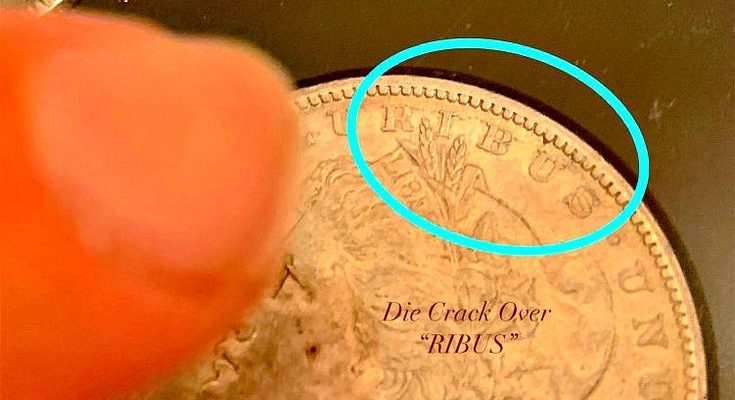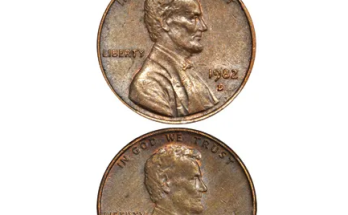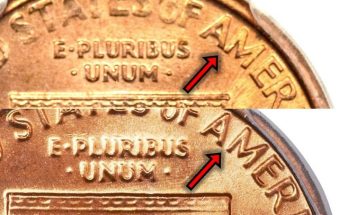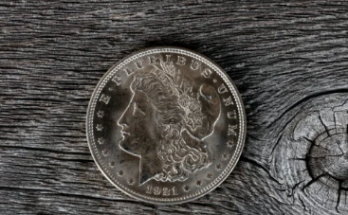This post may contain affiliate links. If you buy thru these links, we may earn a commission at no additional cost to you.
Die break error coins are scarce and valuable collectibles.
So, what exactly is a die break?
Are die breaks and die cracks different?
What about cud error coins?
Today we’ll take a look at coins with die cracks and die cuds (also known as die breaks) and explain:
- What to look for on these error coins
- How these varieties of error coins are made
- How much die break coins are worth
Ready to go on a search for some neat error coins?
Okay… break out your loose change, a 5x-power magnifier glass, and let’s have a look!
Following is the ultimate list of die break error coins to look for.
What Are Die Breaks & How Are They Made?

A coin die imprints a design on a blank coin. Dies are made to strike tens of thousands of coins before becoming too worn to use any further.
Sometimes, coin dies begin showing signs of heavy use before US Mint officials can remove the die and replace it with a new one.
When dies become overly worn and brittle, they usually exhibit wear through minor lines, cracks, and other oddities that form on the die.
Once these die breaks develop, they’re transferred onto the coins — often creating raised (sometimes jagged) lines known as die cracks.
As the die breaks grow, so can the size, length, and magnitude of the error.
Depending on the size and location of the die crack (or die break), these error coins may be worth anywhere from a couple dollars to several hundred dollars — or more!
Here’s the list of die break error coins to look for…
Types Of Die Break Error Coins
Die breaks come in many different forms. Coin collectors have classified these various types of die breaks as distinct varieties, including:
- Die crack — A die crack is one of the most common die defects. It appears as a raised line across the coin — most commonly in the form of what looks like a crack on the coin. (See an example of a die crack)
- Bi-level die crack — Usually, when a die crack occurs, the only visual evidence is a raised line. But sometimes a die crack can displace the coin vertically, creating a stair-step effect. With a bi-level die crack, a segment of the coin on one side of the crack is actually sunken below the remaining area of the coin on the other side. (See an example of a bi-level die crack)
- Die chip — Die chips are small, isolated chunks of metal that break away from the die, usually in the middle of the coin away from the rim. A die chip on a coin appears as a raised mound of metal, and these die chips can range in size from very small to quite large. Most die chips are less than 1 millimeter in size. As die chips grow beyond 1 to 2 millimeters, many error coin experts classify the chip as an interior die break, explained in detail below. (See an example of a die chip)
- Shattered die — Shattered dies occur when various die cracks intersect, this is referred to as a shattered die. Shattered dies may reveal themselves across the entire face of a coin. (See an example of a shattered die)
- Cud — By most definitions, a cud is a raised blob of metal connected to the rim of the coin. Cud error coins occur when a part of the die involving the rim of the coin fails, resulting in break there. Large cuds can sometimes obliterate edge lettering or other design elements near the periphery of the coin. The raised blob of metal forming the cud will generally look like a blank, or flat piece of metal with no design element. (See an example of a cud)
- Interior die crack / Interior die break — Unlike a cud, which is attached to the rim of the coin, an interior die break is a large blob of metal within the coin’s design. Definitions on what constitutes a die chip versus an interior die break vary, though many error coin experts would agree that an interior die crack should measure at least 3 millimeters — though preferably 4 millimeters or wider — in size. Interior die breaks are relatively scarce, and sometimes form along or in conjunction with a die crack. (See an example of an interior die break)

By the way, some coin collectors passionately disagree on the definitions behind one type of die break error versus another. This is particularly true regarding what constitutes a cud versus a die chip / interior die break.
As interest in error coins continues growing, coin collectors may develop even more classifications for die breaks.
Here’s a good example of a Lincoln cent with die cracks:
Are Coins With Die Breaks, Cracks, And Cuds Rare?
While all error coins are by definition rare, die breaks, die cracks, and cud errors are among the more common error coins.
The scarcest ones are generally those that are larger in size or more dramatic in appearance. That’s partly because:
- Large die breaks, cracks, and cuds were made far less frequently.
- Those that were produced were often caught by the US Mint’s quality control team.
So, in general… dramatic appearance, large size, and prominent location on a coin are marks of “rarer” die cracks, breaks, and cuds.
Coins With Die Breaks That Are Popularly Collected
Interest in die breaks varies from collector to collector. Some die breaks are classified as individual varieties that are collected within a particular coin series.
Perhaps this is most strongly the case with the ever-popular Morgan dollars and Peace dollars. These old silver dollars are classified by collectors based on the presence of certain die anomalies — including die breaks.
Morgan and Peace dollar classifications were first popularized by Leroy C. Van Allen and A. George Mallis in their book, The Comprehensive Catalog and Encyclopedia of Morgan and Peace Dollars — and the varieties are shorthanded as “VAMs” (a combination of the initials of Van Allen and Mallis’ last names).
VAM Morgan and Peace dollars, many of which are classified solely on the basis of die breaks, can range in value from $50 to several thousand dollars.
Another popular type of die break involves a raised blob of metal in between the letters “B” and “E” in “LIBERTY” on Lincoln pennies.
These are called “BIE” errors, or BIE Lincoln cents and are also highly collectible. Many range in value from $5 to $50 …and up.
How Much Are Die Break Error Coins Worth?
As with many types of error coins, values for die breaks largely depend on the size, location, and magnitude of the error. The larger, more prominent, or more intrusive the die break, typically the more that coin is worth.
Determining whether you have a die crack coin valued at $5 or an especially valuable error coin worth $100 will depend on the following:
- Where the die break is located
- How big the die break is
- If that die break is classified as a rarity by error coin specialists
- If that particular variety is sought by many collectors
It’s normally fair to presume any die break coin is worth more than the same coin without a die break.
As stated earlier, coins with die breaks fall within a broad spectrum of values — ranging from only a couple dollars to hundreds of dollars or more.
So, the value of coins with die breaks is usually best evaluated on an individual, sight-seen basis.



